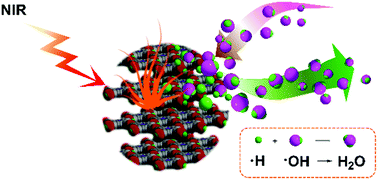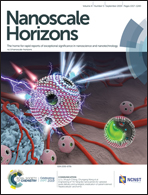Porphyrin–palladium hydride MOF nanoparticles for tumor-targeting photoacoustic imaging-guided hydrogenothermal cancer therapy†
Abstract
Hydrogen gas, which is an important energy resource, was recently discovered to have high advantage in the treatment of many diseases, but the current constraint is the low efficacy of stable hydrogen storage and delivery. By the virtue of the strong hydrogen bonding and catalytic hydrogenation capacity of Pd, we developed a nanoscale porphyrin–palladium metal–organic framework (Pd-MOF) with highly dispersed Pd atoms as hydrogen carriers to efficiently load highly reductive hydrogen for the tumor-targeted photoacoustic imaging (PAI)-guided hydrogenothermal therapy of cancer. The hydrogenated Pd-MOF (PdH-MOF) exhibited a high hydrogen loading capacity, sustained hydrogen release profile, high tumor targeting ability, high photothermal effect and excellent PAI performance. Utilizing these unique advantages of PdH-MOF nanoparticles, high-efficacy hydrogenothermal therapy was achieved by tumor-targeted delivery, PAI-guided therapy, and the sustained release of high payload of highly reductive hydrogen. This study proposes a new strategy for hydrogen storage, activation, delivery and combined therapy using MOFs as a versatile platform.



 Please wait while we load your content...
Please wait while we load your content...